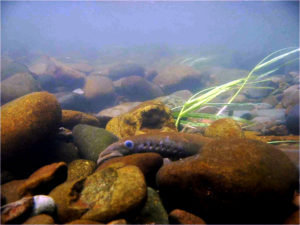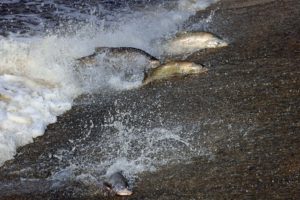The arrival of the rains each fall kicks off spawning season for coho salmon, drawing fish from the ocean up creeks to their inland breeding grounds. This year, the rains also mark the end of another season of work on the Redwood Creek Restoration Project, a long-term effort to revive Marin County’s Redwood Creek watershed.
Sponsored by the National Parks Service and the Golden Gate National Parks Conservancy, the project aims to benefit wildlife dependent on the lower watershed. That includes Central California coho salmon, which have been classified as a federally and state endangered species since 2005. Hopes for a coho revival run high as the restoration enters its second winter.
You can come share those hopes on November 14, when the Parks Conservancy will host a Welcome Back Salmon Celebration at Muir Beach. In the morning, volunteers will contribute to the project by planting nursery-grown creek vegetation and pulling invasive weeds. Later, members of the Federated Indians of Graton Rancheria will lead a traditional salmon blessing, and attendees can share favorite nature readings to wish salmon a healthy return.
And local coho could use all the blessings and help they can get. The fish return to spawn and die every third year, so there are three distinct “year classes” at Redwood Creek. Two of those are “at the brink of extinction,” says fisheries biologist Michael Reichmuth. The third, he adds, is “limping along.”
Reichmuth estimates that only one or two salmon nests, called redds, were constructed during the 2007-2008 and 2008-2009 winters. But salmon watchers logged 23 redds during the 2009-2010 season. “[We’d] like to see redd numbers in the 100 range for all three year classes,” says Reichmuth. That would be enough to maintain a sustainable coho population in Redwood Creek.
The restoration project began in fall 2009, and the following winter saw the highest number of redds constructed in three years.
But Reichmuth says last year’s redd numbers alone don’t show a major positive effect from the restoration. Other figures do point in an encouraging direction. In one survey this summer, he found nearly 200 juvenile coho and steelhead trout in a lagoon that was expanded last year.
“The lagoon expansion is allowing more juveniles to use the space and fatten up to get ready for the time when they are ready to head out to the ocean,” says Aleutia Scott, a natural resources specialist for the National Park Service. Scott reports seeing so many smolt breaking the lagoon’s surface that the water shone with “natural glitter.”
Improvements made in 2010 may also help future coho juveniles. Scott says the team excavated a little over a third of a new creek alignment and constructed three new side channels. With multiple streams, juveniles can escape high flows in the main creek. The fish will also have more shelter, thanks to the myriad native plants that will be planted along the new channels.
But these additions may take a long time to register their full effect: For example, the side channels built this fall won’t connect to the main channel for a couple of years. “It’s a complicated project,” Scott explains, “It may take four or five years.”
In the meantime, she says, there are “plenty of opportunities for people to get out to Muir Beach and see the project.” A volunteer program will run throughout the winter, giving visitors a chance to help keep hope alive for Redwood Creek’s coho salmon.
To learn more, visit the project’s website.

.jpg)



